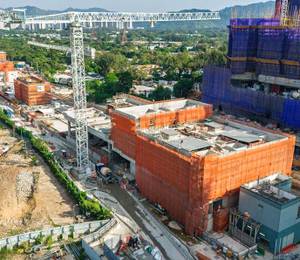The Segment 10 of North Luzon Expressway (NLEX) is a four-lane, 5.65-km-long elevated toll road connecting the NLEX Harbour Link to the C3 Road. Construction work on the project started in 2016 and was completed in 2019.
The Philippines’ Department of Public Works and Highways (DPWH) together with NLEX Corporation inaugurated the NLEX Segment 10 Harbour Link in February 2020, and the road has been operational ever since.
This project is significant as the Segment 10 terminus at C3 Road interfaces with the proposed NLEX-SLEX Connector Road, the last stretch of the extension linking the North and South Luzon Expressways, and the C3-R10 Section which connects the NLEX mainline to the port area.
Value engineering solutions
SMEC provided detailed engineering design (DED) services for the 5.58-km-long viaduct section of Segment 10, which links MacArthur Highway in Valenzuela City and C3 Road in Caloocan City. These included value engineering concepts to improve the financials of the project.
“Our global team developed a suite of complete redesigns and geometric amendments to suit the required reduced carriageway width. This meant amending or redesigning all associated infrastructure including tapers, ramps, bridge arrangement and cross sections, pier and deck layouts, and drainage,” explained SMEC.
In 2015, SMEC carried out the redesign of NLEX Segment 10 to make the project more cost effective. The two separate viaducts were integrated into one substructure support, and the width was reduced from 28 m to 25.6 m.
The integration of two viaducts into one substructure support reduced the deck slab width and number of girders. This has resulted in having a lighter viaduct structure and led the SMEC technical group to further explore value engineering options for the project. As a result, current foundation design was enhanced and introduction of a large monopile foundation was proposed.
According to SMEC, the redesign effort resulted in estimated savings of 20% for the client.
In addition, SMEC also participated in the design services of the Segment 10 project during construction. This has provided a great impact on the construction progress having SMEC providing its technical assistance and on-call services to the contractors and the NLEX project management team.
“SMEC’s proposed value engineering solutions enabled the Segment 10 project to generate large savings that can be used to fund future projects for NLEX,” said Ricardo Yuzon Jr, country manager at SMEC Philippines.
The construction of NLEX Segment 10 also had to take into consideration the North South Railway Project, which is built on the same Philippine National Railways (PNR) right of way, shared Mr Yuzon. “This posed a challenge to the project team, and so land clearances were secured as early as during the design stage to avoid conflicts with the structures to be built underneath the Segment 10 viaduct.
“There were several issues involving right-of-way (ROW) acquisition, which affected the progress of construction. Further delays were averted by prioritising the construction of segments with completed ROWs while working on the problematic areas along the alignment.”
Mr Yuzon added that a launching gantry, a special-purpose mobile gantry crane typically used in bridge building, was deployed on the Segment 10 project. “It helped to fast-track the construction work, especially on the girder erection.”
Since its completion, the NLEX Segment 10 has helped to ease traffic in Metro Manila by providing access to the North Luzon Expressway without passing through the bottleneck on Epifanio Delos Santos Avenue (EDSA), thus improving cargo movement and minimising motorists’ travel time.
The NLEX Segment 10 is part of the 10-km-long NLEX project connecting Manila to the Central Luzon region, via the Bulacan and Pampanga provinces. Construction of the entire expressway started in 2005.
The NLEX project consists of operational Segments 8.1, 9, 10 and the future Segment 8.2. The expressway is operated by NLEX Corporation (formerly Manila Tollways Corporation), a subsidiary of Metro Pacific Tollways Corporation (MPTC).
All images: SMEC















